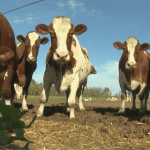
The higher Class III price is the result of both higher cheese and dry whey prices. On the CME barrel cheese averaged $1.53 per pound in September and has ranged from $1.75 to $1.81 in October. The 40-pound block cheddar price averaged $1.76 per pound in September and has ranged from $1.75 to $1.85 in October. Dry whey averaged $0.54 per pound in September and has increased steadily since to now $1.60.
Stronger butter prices and much improved nonfat dry milk price will push the Class IV price which was $15.92 in August and $16.36 in September to $17 for October. Butter which averaged $1.78 per pound in September has ranged from $1.69 to $1.82 in October.
The real strength in the Class IV price came from higher nonfat dry milk prices. Nonfat dry milk averaged $1.35 per pound in September and has shown steady increase since to now $1.52.
Milk production slowing
The increase in milk production over a year ago has slowed and is expected to continue to slow for the remainder of the year. And with the strong seasonal demand for butter and cheese for the holidays cheese and butter prices could strengthen even more.
Class III could improve to the high $18’s November and December. Current Class III futures are higher reaching $19 for both November and December. Class IV could also be in the $18’s November and December.
Milk production April through June was 3.7% higher than a year ago. But since then, the growth in milk production has slowed. July’s production was up 1.9% but August was up just 0.6% and September 0.2%. September’s increase was all due to 27,000 or 0.3% more milk cows than a year ago because milk per cow averaged one pound less.
This is the second consecutive month milk per cow dropped below a year ago partially reflecting some adverse weather and possibly higher feed costs. Thirteen of the 24 selected states had less milk per cow. Milk cow numbers declined 25,000 August to September and by 85,000 from the May peak in numbers.
WI among leaders in production growth
Three of the five top dairy states had relatively strong growth in September milk production with Wisconsin up 3.3%, Texas 2.5% and New York 1.8%, But California’s production was up just 0.2% and Idaho’s 0.2% lower. South Dakota led all states with milk production up 14.6% followed by relatively strong growth in Iowa at 2.5%, Minnesota at 2.4% and Michigan at 1.8%. There were major declines in milk production with New Mexico 12.5% lower, Florida 6.8% lower and Arizona 1.9% lower.
Exports add to higher prices
Dairy exports have also been a factor in higher dairy product prices. The volume of August exports was 13% higher than a year ago. August exports marked the seventh straight month of grow. Compared to a year ago, nonfat dry milk/skim milk powder exports were 15.4% higher, dry whey products 9.2% higher, cheese 18.1% higher and butterfat 150.5% higher.
The growth in milk production for 2022 may be no more than 1.5%. USDA is projecting an increase of just 1.2% over 2021. High feed cost as well as increasing labor and other input costs will encourage heavier culling of lower producing cows. The high cost of building materials will dampen dairy expansion decisions. Milk cow numbers will likely average below 2021. USDA projects the average number of milk cows to be 25,000 head fewer, a decline of 0.3%.
Role of inflation
The economy is forecasted to continue to grow in 2020. But inflation driving up the cost of food, other consumer goods, gasoline and home heating fuel will reduce consumer spending power. But barring any set back to restaurants, in-person learning on schools and colleges and public events increased cheese sales should increase overall milk sales.
Dairy exports are forecasted for some growth over 2021. U.S. dairy products are expected to remain competitive with other major exporters. If progress continues in reducing cases of COVID-19, world economy should show improvement improving world demand for dairy products.
Prices could go either way
Any slight changes in forecasted milk production, domestic sales or dairy exports will change the milk price outlook for 2022. As of now first quarter Class III prices could be in the higher $17’s, second quarter the mid $17’s and in the $18’s third and fourth quarter. But there is the probability that prices could turn out higher or lower.
Dairy producers need to consider one of several price risk management tools to protect profits when opportunities occur. Opportunities currently exist to do so. Class III futures are rather optimistic for 2022 milk prices with Class III in the $18’s January through October. If the growth in milk production continues at the low rate experienced for the past two months, Class III could well be the $18’s for most of next year.
However, USDA is much more cautious with Class III averaging just $17.10 for the year. But if USDA’s projection of just a 1.2% increase in milk production is correct, the Class III price ought to average higher.
Cropp is Professor Emeritus at the University of Wisconsin Cooperative Extension, University of Wisconsin-Madison.























